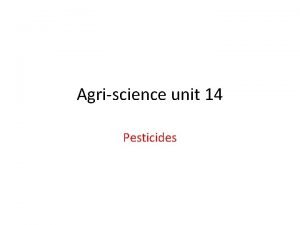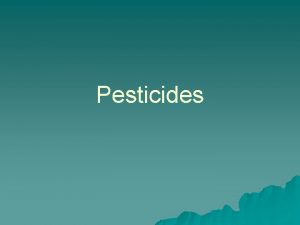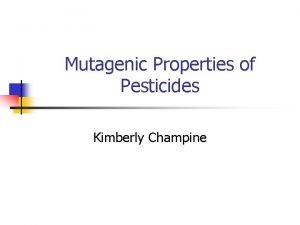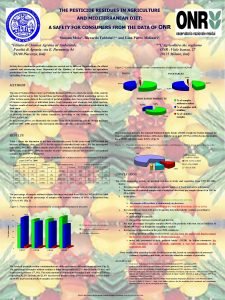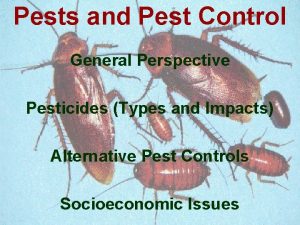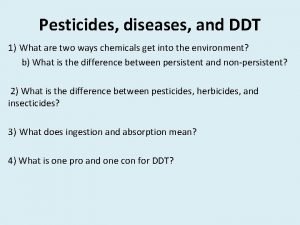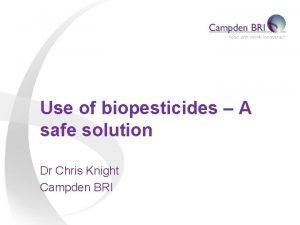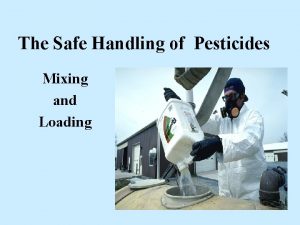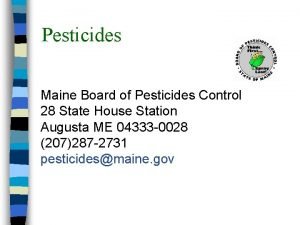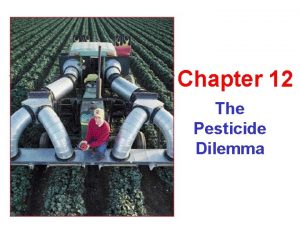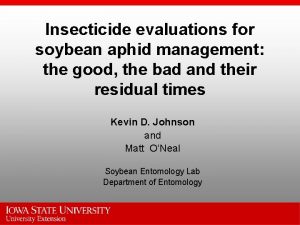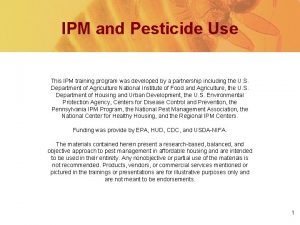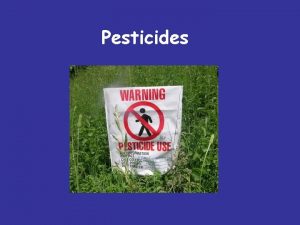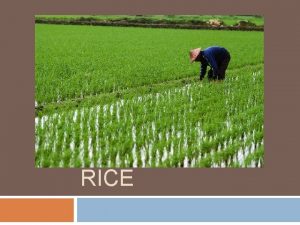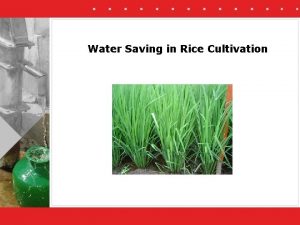Pesticide Use in Rice IPM Introduction Pesticides have











- Slides: 11

Pesticide Use in Rice IPM Introduction Pesticides have of course played a commendable role in increasing our food production and protecting us against disease vectors. However, sole reliance on pesticides has created several problems such as development of resistant pests, pest outbreaks, mortality of useful organisms, adverse effect on human health and environmental degradation. Adverse effects of pesticides prompted scientists to look for environment friendly methods of pest control and consequently IPM was conceptualized. Pesticide spraying

In IPM, different methods of pest control such as resistant varieties, cultural methods, physical methods, natural enemies and pesticides are integrated to suppress pest population without jeopardizing other components of the environment. Pesticides have definite role to play in IPM but their use has to be need-based. Pesticides are important weapons with man against obnoxious pests and their useful life needs to be prolonged application. through their judicious IPM Concept

Judicious pesticide use If pesticides have to play a significant role in pest management, they need to be used in accordance with IPM principles. These have to be used judiciously as last resort and not as first option. Need for pesticide use should be determined through continuous monitoring of pests on crop. Pesticides should only be used if pest incidence tends to approach economic threshold pesticide level. Properly application may timed one very well substitute for 3 -4 ill timed treatments. Pest monitoring

Selective use of pesticides In case pesticide application is unavoidable, preference should be given selective pesticides. Such pesticides are effective against target pest but pose less hazard to non-target organisms such as natural enemies of pests, pollinators and earthworms. Some of such pesticides are buprofezin, which is effective against homopterans like planthoppers, neem, Bacillus thuringiensis (Bt), nucleopolyhedrosis virus (NPV) etc. Earthworms

Natural enemies of pests Pesticides can also be made less hazardous through use of safer Spider formulations such as granules. Pesticide granules like carbofuran 3 G or cartap 4 G prove effective against rice pests without jeopardizing natural enemies of pests. Rove beetle Pesticide should be strictly used in recommended doses avoiding their overuse and misuse. Stenobracon parasitoid

Adverse effects of pesticides can also be reduced by precise placement and proper timing. Foliar application of contact pesticides proves effective against planthoppers only if directed at plant bases and goes waste if carried out on foliage. Likewise, pesticide application against stem borer should coincide with egg hatching. Natural enemies can also be protected through spot application wherein areas with high natural enemy density should not be treated. Sprayer nozzle directed at plant stems

Pesticides recommended against rice pests Planthoppers Apply carbofuran 3 G @ 25 kg/ha or Spray buprofezin 25 SC @800 ml/ha or imidacloprid 17. 8 SL @ 125 ml/ha or chlorpyriphos 20 EC @ 1000 ml/ha Planthoppers Stem borer Apply cartap 4 G @ 25 kg/ha or fipronil 0. 3 G @ 18 kg/ha or Spray cartap 50 WP @500 g/ha or chlorpyriphos 20 EC @1000 ml/ha or quinalphos @ 1250 ml/ha or flubendiamide @ 100 ml/ha Earhead damage due to stem borer

Leaf folder Apply cartap 4 G @ 25 kg/ha or spray cartap 50 WP @ 500 g/ha or chlorpyriphos 20 EC @ 1000 ml/ha or quinalphos @ 1250 ml/ha or flubendiamide 100 ml/ha. Gundhi bug Spray endosulfan 35 EC or malathion 50 EC Leaf folder or quinalphos 25 EC @ 1000 ml/ha or Apply endosulfan or carbaryl or malathion dust @ 25 -30 kg/ha Gundhi bug

Hispa Spray chlorpyriphos 20 EC or quinalphos 25 EC or monocrophos 36 WSC @ 1000 ml/ha or Apply carbaryl dust @ 25 -30 kg/ha Armyworm Hispa beetle Spray chlorpyriphos 20 EC or quinalphos 25 EC @ 1000 ml/ha or Apply carbaryl or malathion dust @ 25 -30 kg/ha Armyworm larva

Economic threshold levels (ETL) of rice insect pests Insect pest Economic threshold level Brown planthopper (BPH) 6 -8 hoppers/hill Whitebacked planthopper (WBPH) 8 -10 hoppers/hill Stem borer 5% dead hearts or 2% white-ears or 1 moth/m 2 or 1 egg mass/m 2 Leaf folder 4% folded leaves Hispa 4% damaged leaves/hill or 2 adults/hill Gundhi bug 1 bug/hill Army worm 1 larva/hill

Let’s Sum Up ØSole reliance on pesticides for pest control has created several problems. ØPesticides are important weapons with man against obnoxious pests and their useful life needs to be prolonged through their judicious application. ØNeed for pesticide use should be determined through continuous pest monitoring on crops and should only be used if pest incidence tends to approach economic threshold level. ØProperly timed single pesticide application may very well substitute for 3 -4 ill-timed treatments. ØPreference should be given selective pesticides that are effective against target pest but pose less hazard to non-target organisms like neem, Bt etc. ØPesticides can also be made less hazardous through use of safer formulations such as granules. ØAdverse effects of pesticides can also be reduced by their precise placement. ØNatural enemies can also be protected through spot application wherein areas with high natural enemy density should not be treated.
 Unit 14 safe use of pesticides
Unit 14 safe use of pesticides Pros and cons of pesticides
Pros and cons of pesticides Pesticides classification
Pesticides classification Mediterranean diet pesticides
Mediterranean diet pesticides Different types of pesticides
Different types of pesticides Example of pesticides
Example of pesticides Bio pesticides example
Bio pesticides example Safe handling of pesticides
Safe handling of pesticides Biopesticides definition
Biopesticides definition Maine board of pesticides
Maine board of pesticides Pesticide treadmill definition
Pesticide treadmill definition Soybean aphid pesticides
Soybean aphid pesticides
